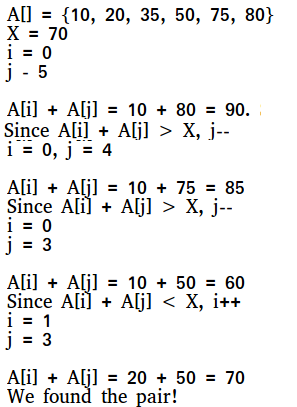C++程序 实现的双指针技术
双指针技术是一种简单有效的技术,通常用于在排序数组中搜索对。
给定一个按升序排序的数组A,其中有N个整数,请找出是否存在任何一对元素(A[i], A[j]),使它们的和等于X。
让我们看一下 最初级的解决方案 。
// 在A [0..N-1]中查找是否存在一对的最初级解决方案。
#include <bits/stdc++.h>
using namespace std;
bool isPairSum (int A [],int N,int X)
{
for (int i = 0; i < N; i ++)
{
for (int j = 0; j < N; j ++)
{
//由于i和j相等表示相同的元素
if (i == j)
继续执行;
//存在对
if (A [i] + A [j] == X)
返回真;
//由于数组已排序
if (A [i] + A [j]> X)
休息;
}
}
//没有找到给定总和的任何对。
返回假;
}
//驱动程序
int main()
{
int arr [] = {3,5,9,2,8,10,11};
int val = 17;
int arrSize = *(&Amp;arr + 1) - arr;
sort(arr,arr + arrSize); //对数组进行排序
//函数调用
cout << isPairSum (arr,arrSize,val);
return 0;
}
输出
1
时间复杂度: O(n 2 )
辅助空间: O(1)
现在让我们看看双指针技术如何工作。我们取两个指针,一个表示数组的第一个元素,另一个表示数组的最后一个元素,然后将保持在这两个指针上的值相加。如果它们的总和小于X,则将左指针向右移动,如果它们的总和大于X,则向左移动右指针,以便更接近总和。我们不断移动指针,直到获得总和为X。
#include <iostream>
using namespace std;
// Two pointer technique based solution to find
// if there is a pair in A[0..N-1] with a given sum.
int isPairSum(int A[], int N, int X)
{
// represents first pointer
int i = 0;
// represents second pointer
int j = N - 1;
while (i < j) {
// If we find a pair
if (A[i] + A[j] == X)
return 1;
// If sum of elements at current
// pointers is less, we move towards
// higher values by doing i++
else if (A[i] + A[j] < X)
i++;
// If sum of elements at current
// pointers is more, we move towards
// lower values by doing j--
else
j--;
}
return 0;
}
// Driver code
int main()
{
// array declaration
int arr[] = { 3, 5, 9, 2, 8, 10, 11 };
// value to search
int val = 17;
// size of the array
int arrSize = *(&arr + 1) - arr;
// Function call
cout << (bool)isPairSum(arr, arrSize, val);
return 0;
}
输出:
1
示例说明:

时间复杂度: O(n)
辅助空间: 因为只使用恒定的空间,所以为O(1)
工作原理是什么?
该算法基本上使用输入数组已排序的事实。我们从最小值和最大值的和开始,并有条件地移动两个指针。当A [i]和A [j]的总和小于X时,我们向左移动指针i。我们不会错过任何一对,因为总和已小于X。同样的逻辑适用于指针j的右侧。
基于双指针技术的更多问题。
- 从两个已排序数组中找到最接近的一对
- 在数组中找到与 x 最接近的一对
- 找到所有三元组的和为零
- 找到一个三元组,其总和等于给定值
- 找到一个三元组,其两个元素的和等于第三个元素
- 找到四个元素,使其总和等于给定值
 极客教程
极客教程